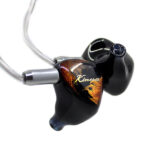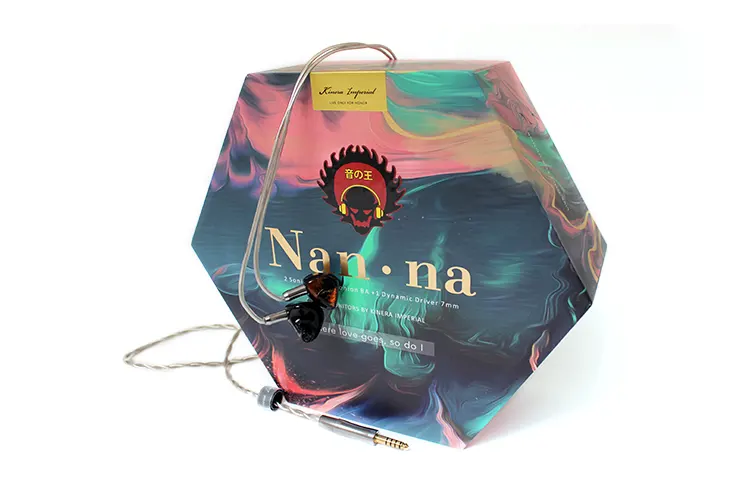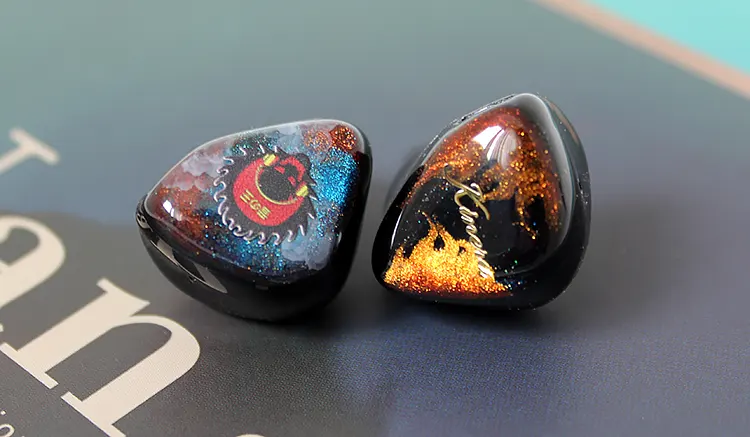In this feature, we review the Kinera Nanna 2.1 Z-Tune Edition which is a hybrid EST, dynamic, and balanced armature universal in-ear monitor. It is priced at $949.00.
Disclaimer: This was sent to us as a sample for our honest opinion. Headfonics is an independent website with no affiliate links or services. We thank the team at Kinera and Linsoul for giving us this opportunity.
To read more on Kinera products we have featured on Headfonics click here.
Note, this article follows our latest scoring guidelines which you can read up on here.
We have come a long way from the original Nanna which was launched back in 2020. The 2nd gen Kinera Nanna 2.0 Pro received praise from the audiophile community for its highly detailed mid-range and excellent price/performance ratio.
The only hitch – an apparently underwhelming mid-bass that restricted the Kinera Nanna 2.0 from its full potential.
In order to revive the hype for the Nanna range, Kinera has taken on the audiophile communities’ feedback and released an upgraded version, resulting in the Kinera Nanna 2.1 Z-Tune Edition.
But how much has changed and can the Kinera Nanna 2.1 finally take the original 2.0 Pro version to its maximum potential? Read on to find out.
Tech Highlights
The Kinera Imperia Nanna 2.1 uses a tri-brid driver configuration consisting of 1 dynamic driver, 1 balanced armature, and 2 electrostatic drivers.
Kinera uses its own custom 7mm dynamic driver in combination with a Sonion 26A008/5 balanced armature and Sonion EST65DA01 electrostatics. The single dynamic driver deals with the low end whilst the balance armatures and e-stats take care of the mid-range and treble regions.
The Kinera Nanna 2.1 has an impedance rating of 60Ω and a sensitivity of 110 dB. The slightly high impedance rating is most likely due to its tri-brid design, and it does require additional power to drive properly to achieve the IEM’s maximum sonic potential.
During testing, the Kinera Nanna 2.1 produced a very dark background and there were no issues in regard to hissing.
Design
The Kinera Nanna 2.1 is a simple yet stylish design. The IEM shells are made out of a jet-black resin or plastic which has a smooth and shiny finish. They are very compact, small, and ergonomic.
This is due to the inner side of the shell having an angled curvature which allows the IEM to fit snuggly against the ear.
Both shells are very lightweight coming in at only 4.5 grams for each shell. The nozzle is quite long, features 3 exit holes for the sound to go through, and has a width of 5.8mm.
The faceplates are very stylish however they come with a catch; the left and right IEM faceplates feature a different design.
The left IEM faceplate is decorated with a sparkly orange and red mist which takes the shape of two flames. The word “Kinera” sits within the center of the faceplate and is donned in shiny, gold lettering giving this side of the IEMs a nice and classy finish.
The right shell has a similar sparkly texture to the left IEM except this time with a color combination of orange, blue, and red. If you look closely enough, a light grey cloud sits behind the Z-Reviews logo.
Based on my own personal taste, the Z-Reviews logo comes off as tacky and does not fit well with the design of the right IEM faceplate. Instead, the gold “Z” which also appears on the box, should have been used instead.
The 2-pin connector holes are not recessed and sit flush with the IEM shell. Furthermore, each shell comes with 3 chamber holes at the top of the IEM to alleviate any unwanted pressure inside the IEMs.
Comfort & Isolation
The Kinera Nanna 2.1 are very comfortable IEMs to wear. They are small, compact, super lightweight at 4.5 grams per shell, and perfect for long listening sessions.
Their ergonomic shape ensures that they fit snugly against the ear during use which provides a very comfortable fit. The long nozzles provide a counterweight to the top part of the IEM shells which results in increased comfort as the weight is evenly distributed.
The snug fit of the Kinera Nanna 2.1 results in excellent isolation with little to no sound leaking out or coming in from one’s surroundings. Using them within an open office or during a train commute did not result in any isolation issues at all and the IEMs were perfect for listening to music in such circumstances.
Tips
One thing which is highly appreciated about Kinera’s IEMs, in general, is that they always, and I mean always, come with a large selection of IEM tips.
It’s as if they do not want you to miss out on achieving the IEM’s maximum potential in sound even if it means you need to go through hours of tip-rolling until you arrive at that place.
With this in mind, the Kinera Nanna 2.1 comes with a large selection of ear tips ranging from foam to Final E to standard silicon tips. Each set of ear tips has its own sound impact according to Kinera being:
- Final Type E Ear tips: Enhances the bass, weaken dental sound
- Foam Ear tips: Rich vocals and deeper bass
- JH-FY009-B Balanced Ear tips (Blue Color): More balanced sound
- RS-B45 Vocal Ear tips (Black Color): Presents the original sound of IEM, vocal is more pleasing
Overall, the most sonically pleasing and technical sound to my ears from the Kinera Nanna 2.1 was achieved when using the “RS-B45 (Black Color)” Vocal ear tips.
These ear tips presented the highest quality level of sound from the Kinera Nanna 2.1 as it provided the most clarity to the mid-range and treble, the best amount of bass texture and quantity, and the widest and tallest soundstage.
This is most likely because these ear tips create the best seal and have the widest bore opening which allows sound to leave the IEM unrestricted.
Stock Cable
The Kinera Nanna 2.1 is supplied with a 6n silver-plated oxygen-free copper cable. The cable comes in a 4-wire configuration and although it is not officially stated, it feels like the wire has a 24 AWG gauge.
Design-wise, the stock cable has a silver color which is finished by a thick, plastic jacket. The jacket has a flimsy and plastic-like feel to it which could be improved. In the middle of the cable, there is a metal splitter and cable ring which comes in a dark grey finish.
They are both small and compact which ensures that the overall cable is not too heavy whilst maintaining the overall comfort of the IEMs during use. The cable features clear plastic ear hooks which lead to the 2pin connectors at the end of the cable which have the same finish as the splitter.
One key upgrade from the Kinera Nanna 2.0 is the inclusion of a module plug system on the new cable which is supplied with the Kinera Nanna 2.1.
This means that the plugs can be interchanged between 2.5mm (balanced), 3.5mm (unbalanced), and 4.4mm (balanced) terminations. The plugs are connected to the main body of the cable via a 4-pin system and are very easy to switch out.
Packaging & Accessories
The Kinera Nanna 2.1 comes in a large hexagonal box that is coated in blue, pink, and teal artwork. The box feels robust and well-designed and provides an interesting unboxing experience.
The main thing you notice is how grand and large the space is inside which allows for most of the accessories to come in full view. Inside, you will find an information pamphlet, alongside a (very) large selection of ear tips, a leather carrying case, a cleaning brush, modular cable plugs, and a warranty card.
The carrying case is a small rectangular leather case that comes in an excellent size for transporting the IEMs and storing them in your pocket or bag for any “on-the-go” adventures. It is sleek, snug, and very easy to use.
The only improvement I could see with the accessories would be an inclusion of an IEM shell sleeve to wrap the shells during transportation in order to prevent scratches or cracks which can occur once the shells braise each other or hit the stock cable plug.
Sound Impressions
The following sound impressions and comparisons were made with IEM’s stock ear tips and cable alongside the Cayin N8ii as the primary source.
Summary
If vocal clarity is your goal, then the Kinera Nanna 2.1 is definitely an IEM that is suitable for this case.
The Kinera Nanna 2.1 focuses on delivering a lush and coherent mid-range which is supported by a forward mid-bass. It utilizes the single balanced armature and electrostatic drivers to push the mid-range forward as it aims to deliver high levels of vocal clarity amongst a slightly warm timbre.
The treble comes off bright with sparkle and where the overall frequency response is supported by a wide soundstage. However, power is key. With more raw power, the Kinera Nanna 2.1 is able to shine with better sonic qualities all around.
Bass
The Kinera Nanna 2.1 received a 3.5db increase within the 5Hz to 100Hz frequency region compared to the Kinera Nanna 2.0 Pro. The result is that you now get around 118db within the 5Hz and 110db at the 100Hz range.
The effect of this is that a single 7mm dynamic driver works overtime to ensure that the sub-bass digs deep when called upon and that the mid-bass is forward in the overall frequency response.
Bass guitars and lower-end beats feel tactile where there is a decent amount of slam and a bass texture.
The only pitfall to this is that the mid-bass comes off slow to decay. You won’t get that “bass head” amount of slam but there is definitely enough mid-bass to support the overall sound and provide it with enough body and fullness.
Mids
The mid-range is where the Kinera Nanna 2.1 shine. Kinera’s aim was to develop an IEM with vocal and instrumental clarity front in mind. The mid-range is very far forward and the most prominent frequency in the overall sound curve.
The lower mid-range remains relatively flat between 200Hz to 500Hz, before picking up between 600Hz and 2k Hz and entering a peak around 115db at 1.8k Hz. The center mid-range then dips slightly to 110db at 3k Hz as it moves into the upper mid-range before rising again to 115db at 4.5k Hz.
The result of this is a relatively flat lower mid-range coupled with a very forward center mid-range. The upper mid-range sounds to my ears in line with the center mid-range and is more forward than the lower mid-range.
Mid-range quality is very high as the Kinera Nanna 2.1 is able to retrieve a very good level of microdetail whilst tying the whole mid-range and treble region together effortlessly to produce a lush and coherent frequency response.
Male and female vocals come off as natural and smooth and are simply a joy to listen to. Instrumentals follow suit where violins and guitars have a high level of tactfulness and realism.
Timbre-wise, there is a slightly warm overall timbre which is driven by the forward mid-bass and center mid-range.
Treble
The treble on the Kinera Nanna 2.1 comes off as sparkly with decent levels of quality and detail. The lower treble comes in at 115db at 5k Hz before dropping to 109db at 6k Hz and picking up again to 115db again at 8k Hz.
For the upper treble range at 10k Hz, this sits at around 105db. This indicates that the lower to center treble is as forward as the center and upper mid-range which sit around 110db to 115db however the upper treble takes a back seat as it tapers off in the frequency response.
Overall, the treble comes off as bright with ounces of sparkle and really good extension to provide sufficient detail. High hats and cymbals sound crisp and sharp without overdoing it or leading to any sibilance.
Staging & Dynamics
The soundstage on the Kinera Nanna 2.1 is very wide and tall. In fact, it is quite impressive how the staging works as it feels very extended, especially in terms of width. The forwardness of the center and upper mid-range plays into the wide soundstage and creates an immersive effect.
The staging is noticeably wider than it is tall. Imaging is very good, and vocals and instruments are placed accurately around the soundstage. Layering is very good with a decent amount of separation and excellent cohesion between instruments and vocals.
Click on page 2 below for pairings and our selected comparisons.







